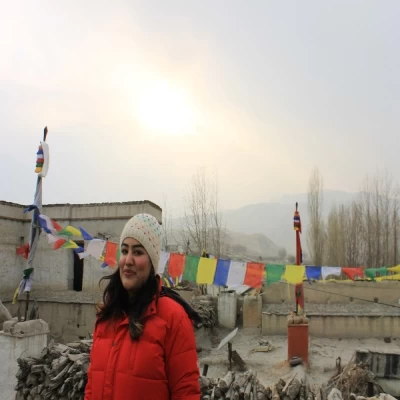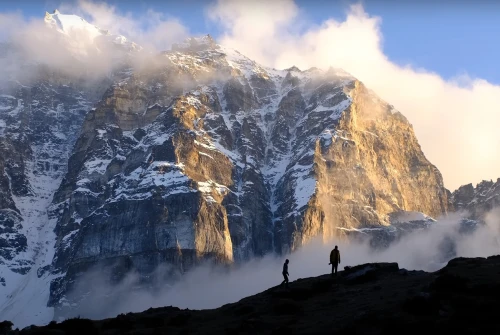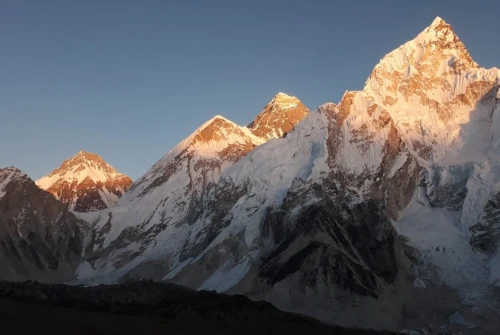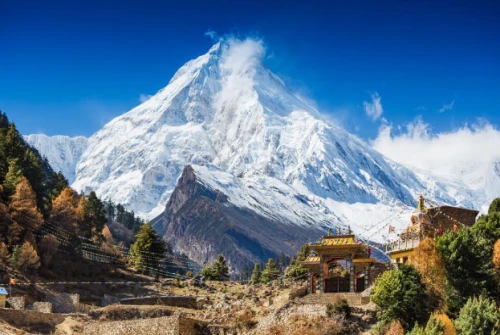Overview
Have you ever dreamed of standing at the foot of some of the world's tallest mountains, surrounded by snow-capped peaks that seem to touch the sky? The Annapurna Base Camp (ABC) trek offers exactly that experience, and November is one of the absolute best times to embark on this incredible journey. Nestled in the heart of the Himalayas in Nepal, this trek takes you through lush forests, traditional villages, and dramatic mountain landscapes before reaching the base camp at 4,130 meters.
November marks the transition from autumn to early winter, bringing stable weather, clear skies, and breathtaking views that make every step worthwhile. Whether you're a seasoned trekker or someone seeking your first high-altitude adventure, the ABC trek in November promises an experience filled with natural beauty, cultural richness, and personal accomplishment.
Why November is the Best Month for the Annapurna Base Camp Trek
Ideal Weather and Temperature in November
November sits comfortably in Nepal's post-monsoon season, which means you'll enjoy some of the most stable weather conditions of the year. The monsoon rains have cleared out by late October, leaving behind crisp, clean air and dry trails. During November, daytime temperatures at lower elevations like Pokhara and the starting points of the trek typically range from 15°C to 20°C (59°F to 68°F), making for comfortable hiking conditions.
As you ascend higher, temperatures naturally drop. At Annapurna Base Camp itself, daytime temperatures hover around -5°C to 5°C (23°F to 41°F), while nighttime temperatures can plunge to -10°C to -15°C (14°F to 5°F). Yes, it's cold, but it's a dry cold that's far more manageable than the damp chill you might experience during other seasons. The key is proper layering, which we'll discuss later.
Perfect Visibility for Panoramic Views
If there's one thing that makes November truly special for the ABC trek, it's the visibility. After the monsoon clears the atmosphere of dust and humidity, you're left with some of the clearest skies imaginable. The views of Annapurna I (8,091m), Annapurna South, Machapuchare (Fishtail), Hiunchuli, and dozens of other peaks are simply spectacular.
Imagine waking up at dawn, stepping out of your lodge, and seeing the first rays of sunlight painting the mountains in shades of pink and gold. That's not just a possibility in November—it's practically guaranteed on most days. The stable weather patterns mean fewer cloudy days and more opportunities for those Instagram-worthy photographs that'll make your friends back home jealous.
Festivals and Cultural Celebrations During November
November also offers a unique cultural dimension to your trek. While the major festivals like Dashain and Tihar typically fall in October, their celebratory atmosphere often extends into early November in mountain villages. You might still catch glimpses of decorated homes, oil lamps flickering in windows, and locals dressed in their finest traditional attire.
The Gurung and Magar communities along the trail often celebrate their harvest festivals during this period, offering trekkers a chance to witness authentic cultural practices. These interactions add depth to your journey, transforming it from a simple mountain trek into a genuine cultural immersion.
Scenic Beauty You Can Expect in November
Autumn Colors and Landscapes
November in the Annapurna region is like walking through nature's own art gallery. The tail end of autumn means you'll still catch some gorgeous foliage, particularly in the lower regions. The rhododendron forests that dominate the middle elevations take on golden and bronze hues, creating a stunning contrast against the deep green of pine and oak trees.
The terraced fields you'll pass through in villages like Ghandruk and Chhomrong showcase the results of the recent harvest. The landscape has a tidiness to it; the fields are cleared, the trails are dry, and everything feels fresh and renewed. It's completely different from the lush green of monsoon season or the snow-buried paths of deep winter.
Crystal Clear Mountain Views
We've mentioned visibility, but it bears repeating: the mountain views in November are phenomenal. The Annapurna Sanctuary, which is what locals call the natural amphitheater formed by the surrounding peaks, reveals itself in all its glory. On a clear November day, you can see the entire ring of mountains that surrounds the base camp with such clarity that you can make out individual ridges and glaciers.
Machapuchare, the sacred "Fishtail" mountain, appears so close you feel like you could reach out and touch it. The south face of Annapurna I looms above you with an intimidating presence that reminds you just how small we are in the face of these natural giants. These aren't views you glimpse through breaks in the clouds; they're constant companions throughout your trek.
Flora and Fauna Along the Trail
The biodiversity of the Annapurna Conservation Area is remarkable, and November offers excellent wildlife viewing opportunities. While you're unlikely to spot the elusive snow leopard, you might see Himalayan thars (a type of wild goat), various species of pheasants, and, if you're lucky, the colorful Danphe (Himalayan monal), Nepal's national bird.
The forests at mid-elevations are home to langur monkeys, and you'll definitely hear the calls of numerous bird species. The vegetation transitions dramatically as you climb, from subtropical forests filled with bamboo and rhododendron at lower elevations to alpine meadows and sparse vegetation near the base camp. November's dry conditions make these changes even more pronounced and easier to appreciate.
Trek Difficulty and Trail Conditions in November
How the Weather Affects Trail Difficulty
November's weather makes the ABC trek in Nepal more accessible than you might expect. The dry conditions mean the trails are in excellent shape, no muddy sections, no slippery rocks from rain, and no leeches (which are a genuine problem during monsoon season). The stone steps are dry and provide good traction, and the suspension bridges aren't slick with moisture.
That said, the increasing cold as you gain altitude does add a challenge. Your body works harder in cold conditions, and the thin air at higher elevations means you'll be breathing more heavily. The trek is considered moderate in difficulty, but don't underestimate it. You'll be hiking for 5-7 hours most days, with significant elevation gains and losses.
The trail from Nayapul to Annapurna Base Camp and back typically takes 7-12 days, depending on your pace and acclimatization needs. November's stable weather means fewer delays and a more predictable schedule, which is great for those with limited time.
Tips for Trekking Safely in November
Safety should always be your top priority. Here are some November-specific tips:
Start early each day. The mornings offer the best weather and visibility, plus you'll reach your destination with plenty of daylight to spare. Trek at your own pace—this isn't a race. Listen to your body and take breaks when needed. Stay hydrated even though it's cold. You lose moisture through breathing at altitude, and dehydration compounds altitude sickness symptoms.
Watch for ice on the trail, especially in shaded areas and at higher elevations. The early morning frost can make some sections slippery. Trekking poles are invaluable for stability. Always check weather forecasts before heading to higher camps. While November is generally stable, mountain weather can change rapidly.
Hire a local guide if you're not experienced with high-altitude trekking. They know the terrain, can help with acclimatization, and provide invaluable cultural insights. Plus, you're supporting the local economy.
Accommodation and Food During the Trek
What Type of Lodges and Tea Houses You'll Find
The Annapurna Base Camp trek is well-developed with an extensive network of tea houses and lodges along the route. These aren't luxury hotels, but they're comfortable, clean, and provide everything you need. A typical tea house offers simple rooms with twin beds, basic mattresses, pillows, and blankets. Some have attached bathrooms, though shared facilities are more common at higher elevations.
In November, most lodges have their heating systems operational, though "heating" often means a central dining room with a bukhari (wood-burning stove). Rooms themselves are usually unheated, which is why a good sleeping bag rated for cold temperatures is essential. The lodges become progressively more basic as you ascend, but even at Annapurna Base Camp, you'll find adequate shelter.
Meals and Local Delicacies to Try
Tea house dining rooms are social hubs where trekkers from around the world gather to share stories. The menus are surprisingly extensive, offering everything from traditional Nepali dishes to Western comfort food. Dal bhat (lentil soup with rice) is the staple meal and comes with unlimited refills, it's nutritious, filling, and provides the energy you need for trekking.
Don't miss trying momo (Nepali dumplings), thukpa (noodle soup), and Sherpa stew. These warming dishes are perfect for November's cooler temperatures. Garlic soup is popular among trekkers for its supposed altitude sickness prevention properties, though its efficacy is more folklore than fact. For breakfast, porridge, pancakes, and eggs are standard options.
As you climb higher, menu options become more limited and prices increase (everything has to be carried up by porters). That's completely understandable and expected. The food is generally safe to eat, but stick to cooked items and avoid raw vegetables at higher altitudes.
How Busy Are the Lodges in November?
November is part of the peak trekking season, which means lodges can get busy, especially at popular stops like Chhomrong, Deurali, and Machapuchare Base Camp. However, the crowds are manageable—nowhere near the shoulder-to-shoulder conditions you might find on trails like Everest Base Camp.
You'll usually find accommodation without prior booking, though it's wise to arrive at your destination by early afternoon to secure a room. Traveling with a guide or porter can help, as they often have relationships with lodge owners and can arrange accommodation in advance.
The social aspect of busy lodges is actually a positive. You'll meet fellow trekkers, share experiences, and build friendships that often last beyond the trail. There's something special about bonding with strangers over shared challenges and spectacular views.
Traditions, People, and Culture Along the Route
Gurung and Magar Communities
The Annapurna region is predominantly inhabited by Gurung and Magar people, ethnic groups with rich cultural traditions and a long history in these mountains. These communities are known for their bravery—many serve in the British and Indian Gurkha regiments. As you trek through villages like Ghandruk, Chhomrong, and Sinuwa, you'll be walking through their ancestral lands.
The traditional stone houses with slate roofs, terraced fields carved into impossible hillsides, and the warm smiles of the locals all tell a story of resilience and adaptation to mountain life. Many villagers supplement their farming income by operating tea houses, working as guides and porters, or selling handicrafts to trekkers.
Religion and Cultural Practices
The spiritual landscape of the trek is fascinating. You'll encounter both Hindu and Buddhist influences, often blended in unique ways. Prayer flags flutter in the wind at high passes, stupas mark important trail junctions, and small shrines dot the landscape. Machapuchare is considered sacred, and climbing it is prohibited; it's never been summited, maintaining its spiritual purity.
The local people practice a syncretic religion that incorporates elements of Buddhism, Hinduism, and older animistic beliefs. You might see shamans performing rituals, or notice offerings left at natural springs and tree groves. These practices reflect a deep connection between the people and the mountains they call home.
Hospitality and Lifestyle in the Himalayas
Himalayan hospitality is legendary, and you'll experience it firsthand on this trek. Despite their modest means, lodge owners and villagers treat guests with genuine warmth. They'll share stories, offer advice on the trail ahead, and often go out of their way to make you comfortable.
Life in these mountain villages follows rhythms that have changed little over centuries. People wake with the sun, tend their animals, work their fields, and gather in the evening around the fire. There's no rush, no constant digital connectivity (though some lodges now offer wifi), just a simpler, more connected way of living. It's a refreshing contrast to modern life and offers a valuable perspective.
Packing List for the Annapurna Base Camp Trek in November
Essential Trekking Gear
Proper gear can make the difference between a comfortable trek and a miserable one. Here are the non-negotiables:
A quality backpack (40-50 liters if carrying your own gear, 25-30 liters if using porter services). A sleeping bag rated to at least -10°C to -15°C (14°F to 5°F), you can rent these in Pokhara if you don't want to travel with one. Trekking poles to reduce stress on your knees during descents and provide stability on uneven terrain. A headlamp with extra batteries for early morning starts or evening bathroom trips. A water bottle or hydration system, bring purification tablets or a filter. Sunglasses with UV protection and a sun hat for daytime. A warm hat for cold mornings and evenings.
Layering Clothes for Autumn Conditions
Layering is the key to comfort in November's variable temperatures. You'll be warm while hiking during the day but cold at rest stops and in the evenings.
Base Layer (Inner Layer)
Your base layer should be moisture-wicking and quick-drying. Merino wool or synthetic fabrics work best; avoid cotton, which stays wet and leaves you cold. Bring at least two sets so you can wash one while wearing the other. Long-sleeve tops and long underwear bottoms are essential.
Mid Layer (Insulation Layer)
This layer traps heat and provides insulation. A fleece jacket or lightweight down jacket works perfectly. You might want two options: a lighter fleece for hiking and a warmer down jacket for evenings and higher altitudes. A synthetic insulated jacket is also a good choice as it insulates even when damp.
Outer Layer (Shell Layer)
Your outer layer protects against wind, rain, and snow. A waterproof, breathable jacket is essential, even though November is generally dry. Mountain weather is unpredictable, and you might encounter snow at higher elevations. Waterproof pants are also important; they can be worn over your trekking pants when needed.
Lower Body and Feet
Comfortable trekking pants that dry quickly are perfect for hiking. Bring at least one pair of warm pants or thermal leggings for evenings. Your footwear is critical; broken-in hiking boots with good ankle support and traction are non-negotiable. Bring several pairs of moisture-wicking socks and one pair of warmer socks for sleeping.
Gaiters can be useful if you encounter snow, though they're not essential for November. Camp shoes or sandals for wearing around lodges give your feet a break in the evenings.
Head and Hands
A warm beanie or hat for cold mornings and evenings is essential. Bring a sun hat with a brim for daytime protection. Gloves are critical; bring a warm pair for high altitudes and a lighter pair for hiking. Some trekkers prefer glove liners under warmer mittens for maximum flexibility and warmth.
A neck gaiter or buff protects against wind and cold, and can double as a headband or face covering.
Must-Have Accessories and Gadgets
Beyond clothing, these items enhance your trek:
A camera or smartphone with extra batteries or a portable charger, those mountain views demand to be captured. Personal toiletries, including toilet paper, wet wipes, hand sanitizer, and biodegradable soap. A first aid kit with basics like bandages, blister treatment, pain relievers, and any personal medications. Sunscreen with high SPF and lip balm with SPF, the sun is intense at altitude. A small towel that dries quickly. Snacks like energy bars, nuts, or chocolate for trail energy. A book or e-reader for evenings at the lodge. Earplugs if you're a light sleeper (lodges can be noisy). Ziplock bags to keep electronics and documents dry.
Health and Safety Tips for Trekking in November
Acclimatization and Altitude Sickness
Altitude sickness is the most serious health concern on the ABC trek. Annapurna Base Camp at 4,130 meters is high enough that some people experience symptoms. The key to prevention is proper acclimatization, ascending gradually, and allowing your body time to adjust.
The golden rule is "climb high, sleep low." Your itinerary should include rest days or shorter hiking days to help with acclimatization. Common symptoms of altitude sickness include headache, nausea, dizziness, fatigue, and difficulty sleeping. Mild symptoms are normal and usually resolve with rest and hydration.
However, if symptoms worsen or you develop severe symptoms like confusion, difficulty walking, or shortness of breath at rest, you must descend immediately. Altitude sickness can be life-threatening if ignored. Don't let summit fever override your safety; the mountains will always be there for another attempt.
Stay well hydrated, even though you might not feel thirsty in the cold. Avoid alcohol and smoking, which exacerbate altitude effects. Eat regular meals even if you're not hungry; your body needs fuel. Some trekkers take Diamox (acetazolamide) as a preventive measure, but consult a doctor before your trek about this option.
First Aid and Emergency Plans
Carry a comprehensive first aid kit and know how to use it. Common trail ailments include blisters, minor cuts, stomach issues, and muscle strains. Treat blisters immediately with moleskin or blister pads before they become serious problems. Bring anti-diarrheal medication and rehydration salts for stomach issues.
Know the location of health posts along the trail. There are small clinics in Chhomrong and at Machapuchare Base Camp, though facilities are basic. Your guide should carry a satellite phone or have access to communication for emergencies. Evacuation by helicopter is possible but expensive; make sure you have comprehensive travel insurance that covers high-altitude trekking and emergency evacuation.
Travel insurance is non-negotiable. Verify that your policy covers trekking up to 4,500 meters and includes emergency helicopter rescue. Keep emergency contact numbers written down and share your itinerary with someone back home.
Conclusion
The Annapurna Base Camp trek in November offers an extraordinary combination of perfect weather, stunning visibility, rich cultural experiences, and manageable trail conditions. Standing at the base camp, surrounded by a 360-degree panorama of some of Earth's highest peaks, you'll understand why this trek is considered one of the most spectacular in the Himalayas.
November's crisp autumn days, clear mountain views, and stable weather create ideal trekking conditions. Yes, it's cold at higher elevations, but proper preparation makes it entirely manageable. The cultural richness of the Gurung and Magar villages, the warm hospitality of tea house owners, and the camaraderie among fellow trekkers add dimensions to the journey that go far beyond the physical challenge.
Whether you're seeking personal achievement, natural beauty, cultural immersion, or simply an escape from everyday life, the ABC hike trail in November delivers on all fronts. With proper preparation, reasonable fitness, and respect for the mountains, this trek will give you memories and photographs that last a lifetime. The Annapurna Sanctuary Route is calling, will you answer?
FAQs
1. Is November too cold for the Annapurna Base Camp trek?
While November brings cold temperatures, especially at higher elevations, it's definitely not too cold with proper preparation. Daytime temperatures at base camp range from 5°C to 5°C, and nighttime temperatures can drop to -15°C. With appropriate layering, a good sleeping bag, and the heated dining rooms at tea houses, the cold is manageable. Many trekkers actually prefer November's crisp, dry cold to the damp conditions of other seasons. The spectacular views and stable weather more than compensate for the chilly temperatures.
2. Do I need previous trekking experience to do the ABC trek in November?
You don't need previous high-altitude trekking experience, but reasonable fitness is essential. The trek involves 5-7 hours of hiking daily with significant elevation changes. If you can comfortably walk for several hours and handle stairs, you can do this trek. However, it's wise to train beforehand with cardiovascular exercise and practice hiking with a loaded backpack. November's good trail conditions actually make it more accessible for less experienced trekkers compared to the monsoon season.
3. Can I trek solo, or should I hire a guide and porter?
You can legally trek solo on the ABC route, and many people do. The trail is well-marked, and there are plenty of tea houses for accommodation. However, hiring a guide offers significant benefits: local knowledge, help with acclimatization decisions, cultural insights, language assistance, and added safety. A porter can carry your main pack, letting you hike with just a daypack, which makes the trek much more enjoyable. Supporting local guides and porters also contributes directly to the mountain economy.
4. How difficult is altitude sickness on this trek, and how can I prevent it?
Altitude sickness is a real concern on the ABC trek, as you'll reach 4,130 meters. However, the trek profile allows for good acclimatization if you ascend gradually. Most itineraries include rest days and follow altitude gain guidelines. Prevention strategies include ascending slowly, staying well hydrated, avoiding alcohol, eating regular meals, and listening to your body. Some trekkers take Diamox preventively after consulting with their doctor. The key is recognizing symptoms early and being willing to descend if they worsen.
5. What permits do I need for the Annapurna Base Camp trek?
You'll need two permits: the Annapurna Conservation Area Permit (ACAP) and the Trekkers' Information Management System (TIMS) card. The ACAP costs around $30 for foreigners and helps fund conservation efforts in the region. The TIMS card costs approximately $20 and helps authorities track trekkers for safety. Both can be obtained in Kathmandu or Pokhara through registered trekking agencies or tourism offices. Your guide can typically arrange these permits for you. Keep them with you throughout the trek as you'll need to show them at various checkpoints.



 based on 11 reviews
based on 11 reviews

